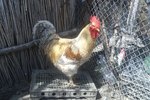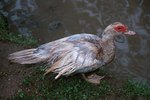
For the backyard breeder, telling the difference between male and female geese is essential when space is limited. Several breeds of grey goose are commonly available from hatcheries and feed stores. Most hatcheries provide the option of your goslings arriving pre-sexed, but purchasing from a feed store leaves it to you to discern the difference.
Pilgrim Geese
Pilgrim geese are among the various types of grey geese. You can easily discern males from females of the pilgrim breed just by looking at them. Adult males are pure white with accents of gray on their wing and body feathers. Females are gray with white faces and bellies. The goslings begin to take on shades of gray or white at 12 to 14 days old, although you can usually tell female geese at a younger age by their darker bill coloring.
Other Breeds
Other common breeds of grey goose include Toulouse and African grey. Males and females of both species look and act the same, although male vocalizations will tend to be noisier and higher-pitched. Males are larger; females may have low-slung bulges behind their legs during egg-laying season as well as enlarged vents under their tails. Male Africans develop more-pronounced bulges at the bases of their beaks at 2 to 3 years of age.
References
Photo Credits
-
Jupiterimages/Photos.com/Getty Images
Writer Bio
Indulging her passion for vacation vagary through the written word on a full-time basis since 2010, travel funster Jodi Thornton-O'Connell guides readers to the unexpected, quirky, and awe-inspiring.



